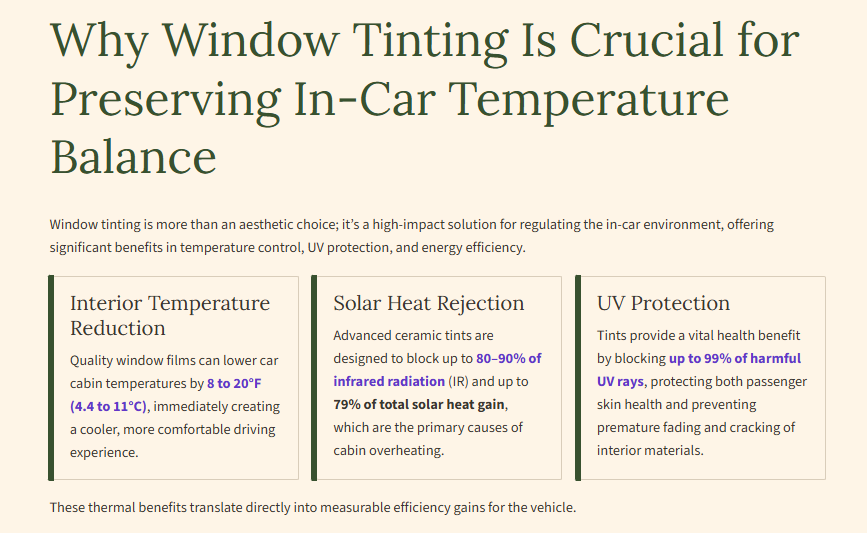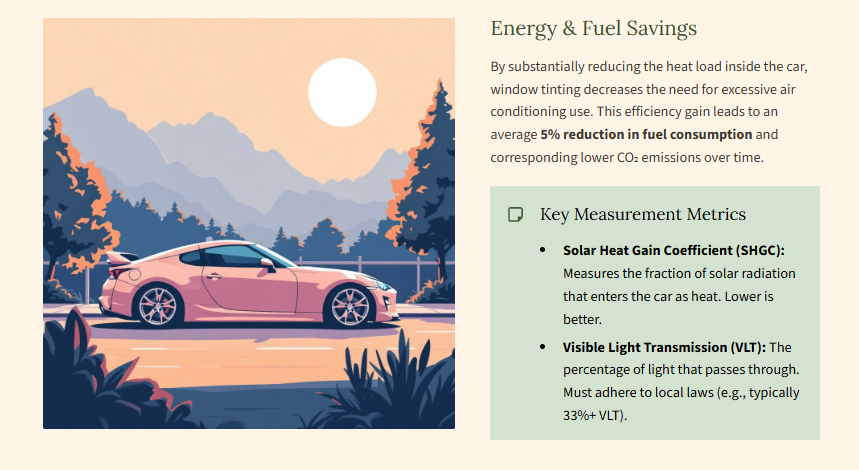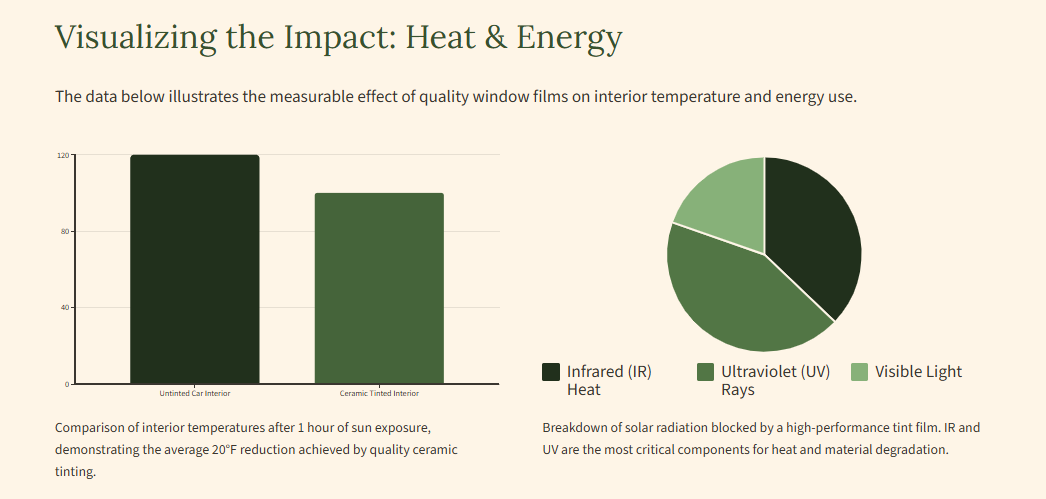Every vehicle faces one invisible but constant challenge — managing internal heat. Whether parked under direct sunlight or idling during a commute, the cabin becomes a miniature heat trap. This rise in temperature isn’t just about discomfort; it affects materials, electronics, and even how efficiently your cooling system works. Over time, that imbalance leads to faster wear and unnecessary energy use.
At Infinite Auto Works, we study the environmental and mechanical factors that affect vehicles at a deeper level. Understanding how window tinting contributes to temperature balance is crucial for maintaining long-term interior health. From reducing infrared radiation to stabilizing cabin conditions, tinting is more than a style choice — it’s a layer of functional science that supports your car’s equilibrium.

Understanding In-Car Temperature Balance
What Happens When Sunlight Enters Your Vehicle
When sunlight hits a car, it passes through glass and transforms into heat once it interacts with surfaces like seats, dashboards, and panels. The heat then becomes trapped inside the enclosed cabin, causing temperatures to rise far beyond outdoor levels.
This heat buildup can be surprisingly rapid. Within 10 minutes of direct sun exposure, an interior can reach 110°F (43°C). After 30 minutes, temperatures may exceed 130°F (54°C). Without proper protection, this repeated cycle causes material breakdown and impacts driver comfort significantly.
The Science Behind Heat Trapping in Car Interiors
The process begins with shortwave solar radiation entering the car. Once absorbed, it’s re-emitted as longwave infrared radiation, which cannot easily pass back through glass. This results in a thermal feedback loop — similar to how a greenhouse retains warmth.
This “thermal entrapment” effect explains why cars heat up even on mild days. The lack of ventilation and reflective shielding amplifies the stored energy, creating sustained interior heat long after the engine shuts off.
The Connection Between Sunlight and Cabin Temperature
The Role of Infrared and Ultraviolet Radiation
Sunlight contains two key energy bands that affect vehicles — UV (ultraviolet) and IR (infrared) radiation. UV rays damage materials at the molecular level, causing fading and deterioration. Infrared rays, on the other hand, are responsible for heat. They make up more than 50% of solar energy that enters through glass.
While UV radiation weakens materials, infrared energy builds heat pressure within the cabin. The balance between these two forces determines how fast temperatures rise inside your car.
How Regular Automotive Glass Amplifies Heat
Standard automotive glass is designed for visibility and impact safety, not for heat filtration. It blocks only about 30% of UV rays and allows most infrared energy to pass through. This transparency to heat energy contributes to the quick rise in internal temperature — a phenomenon that becomes worse in darker interiors, where surfaces absorb more heat.
Window Tinting as a Temperature Stabilizer
How Window Tinting Blocks Heat Transmission
Window Tinting Concord NC serves as a selective barrier. It filters out specific wavelengths of light that contribute to heating while allowing visible light to pass. Quality tint films can reject up to 99% of UV rays and a large portion of infrared energy, effectively lowering internal temperature without compromising clarity.
This isn’t just about surface cooling — it’s about altering how energy interacts with glass. By reducing total solar transmission, window tinting helps maintain a more consistent in-car temperature throughout the day.
The Physics of Light Reflection and Absorption in Tinted Glass
Tint films contain microscopic particles that either absorb or reflect radiation. Ceramic and metallic coatings, in particular, scatter infrared rays before they enter the cabin. This changes the balance between absorption (what the car keeps) and reflection (what it repels). The result is a significant reduction in heat buildup even under continuous sunlight exposure.
The Greenhouse Effect Inside Vehicles
How Heat Builds Up in a Parked Car
When a vehicle is parked in direct sunlight, solar energy enters faster than it can escape. Seats, dashboards, and trims absorb and re-radiate this energy, trapping heat. The air inside the vehicle continues to warm, creating a closed-loop thermal buildup — much like an oven effect.
Why Window Tinting Helps Disrupt the Heat Cycle
By minimizing infrared penetration, window tinting slows down the rate of heat accumulation. It doesn’t completely block heat — rather, it alters how much energy is allowed in. This balance prevents sudden temperature spikes and supports a steady internal environment that’s easier for the air conditioning system to manage.
How Different Tint Technologies Affect Temperature Balance
Dyed, Metallic, Carbon, and Ceramic Films: A Functional Overview
Each tinting technology handles heat differently:
- Dyed films absorb light energy but have limited infrared rejection.
- Metallic films reflect sunlight effectively but may interfere with signals.
- Carbon films offer moderate infrared blocking with consistent performance.
- Ceramic films provide superior thermal control by rejecting both infrared and UV energy.
Among these, ceramic tinting is most efficient in maintaining stable cabin temperatures without signal disruption — ideal for vehicles equipped with GPS, sensors, or connected devices.
Measuring Infrared Rejection and UV Protection in Practice
Infrared rejection rates are measured through Total Solar Energy Rejected (TSER) values. The higher the TSER, the better the tint controls heat. Ceramic films typically achieve TSER ratings above 60–70%, meaning they significantly reduce the energy entering through glass surfaces.
The Relationship Between Cabin Temperature and Comfort
Human Thermal Comfort Thresholds in Cars
The average comfort zone for passengers lies between 68°F and 77°F (20–25°C). Once cabin temperatures exceed this range, human performance, reaction time, and focus begin to decline. Window tinting maintains a balanced environment, helping drivers remain alert and comfortable even under intense sunlight.
Window Tinting and Perceived Cooling Efficiency
When heat levels are reduced before they enter the cabin, the air conditioning system operates more efficiently. This doesn’t just make the air feel cooler — it prevents large temperature swings that cause discomfort. The stable temperature balance achieved through tinting translates into smoother thermal comfort across varying driving conditions.
The Impact of Temperature on Vehicle Components
Dashboard and Plastic Degradation Due to Heat
High interior temperatures accelerate chemical reactions in polymers and plastics. Over time, dashboards crack, steering wheels harden, and adhesive bonds weaken. Repeated heating and cooling cycles also release volatile organic compounds (VOCs), which can create fogging on glass surfaces.
How Electronics and Sensors Respond to Elevated Heat Levels
Modern vehicles rely heavily on sensors, screens, and control units that are heat-sensitive. Prolonged exposure to high cabin temperatures can cause pixel degradation, circuit failure, or calibration drift. Window tinting protects these systems by maintaining a cooler environment that supports operational stability.
Environmental Factors That Influence Cabin Heat Levels
Urban Heat Islands and Reflective Environments
In urban areas, glass buildings and paved roads amplify heat through reflection. Vehicles parked in these zones experience intense radiant exposure even when not directly under sunlight. Tinted windows help regulate incoming radiation by reflecting a portion of this energy before it can enter the vehicle.
Climate Conditions and Their Impact on Heat Retention
Humidity and temperature interplay also affect heat perception. High humidity traps heat within the air, slowing cooling. In regions with extreme summer temperatures, tinting becomes essential for maintaining an acceptable thermal balance and minimizing stress on cooling systems.
The Energy Balance Between Sunlight and Cooling Systems
The Science of Heat Load and Air Conditioning Demand
Every additional degree of interior heat adds to the air conditioning workload. This not only consumes more fuel or battery energy but also increases wear on the compressor. Managing this “thermal load” through window tinting reduces energy demand at its source — the sunlight itself.
How Window Tinting Reduces the Energy Cycle in Vehicles
By rejecting infrared heat before it enters, window tinting limits the amount of energy the A/C must counteract. The result is faster cooling, lower system strain, and more balanced energy consumption. For electric and hybrid vehicles, this directly contributes to better range and efficiency.
Long-Term Benefits of Regulated Cabin Temperatures
Slower Material Aging and Color Preservation
A balanced thermal environment extends the life of fabrics, plastics, and upholstery. Consistent temperature levels prevent fading and brittleness, preserving the interior’s visual and structural integrity over time.
Energy Conservation and System Efficiency Over Time
Reducing energy cycles in climate control systems supports mechanical longevity. Air conditioning components operate under less pressure, and the overall cabin ecosystem experiences reduced stress — a long-term advantage rooted in basic thermal physics.
Data-Driven Findings on Cabin Heat and Tint Efficiency
Real-World Temperature Tests and Research Insights
Field studies show that tinted cars can maintain interior temperatures up to 30°F cooler than non-tinted vehicles under the same conditions. These differences are most pronounced in mid-afternoon, when solar intensity peaks.
Key Findings from Automotive Environmental Studies
Research from climate simulation chambers reveals that window tinting not only cools the cabin faster but also slows the temperature rise once the vehicle is turned off. This indicates a measurable reduction in stored heat energy, proving tinting’s effectiveness as a thermal control mechanism.
Infinite Auto Works’ Perspective on Heat Control and Longevity
Observations on Cabin Temperature Regulation
Through years of working with diverse vehicle systems, Infinite Auto Works has observed that maintaining consistent cabin temperature is directly linked to vehicle longevity. Reduced heat stress supports not just comfort but also the mechanical and electronic stability of the car.
Why Scientific Awareness Leads to Smarter Vehicle Care
When drivers understand how sunlight affects the internal environment, they make informed decisions rooted in science rather than appearance. Window tinting, viewed through this lens, becomes an essential thermal control measure rather than an accessory.
Infinite Auto Works Serving the North Concord and Beyond in Concord, NC
Infinite Auto Works is dedicated to serving the diverse needs of the local community of Concord, NC including individuals residing in neighborhood like North Concord With its convenient location near landmarks such as the “Crestview Huntington Apartments, Harris Teeter” major intersections like “Concord Pkwy N (US-601) & Branchview Dr NE (NC-73) and Central Dr NW & Davidson Dr NW” (coordinates: 35.429915841946254, -80.60676316984699) We offer Window tinting services.
Get Window tinting Services at North Concord now
Navigate from North Concord to Infinite Auto Works
Why Window Tinting Is Crucial for Preserving In-Car Temperature Balance?
- Interior Temperature Reduction: Quality window tint can lower car cabin temperatures by 8 to 20°F (4.4 to 11°C), transforming a sweltering vehicle into a cooler, more comfortable space.
- Solar Heat Rejection: Advanced ceramic tint block up to 80–90% of infrared radiation and up to 79% of total solar heat gain, the main drivers of interior heat buildup.
- UV Protection: Tint block up to 99% of harmful UV rays, preventing interior fading and protecting passengers’ skin.
- Energy & Fuel Savings: By reducing heat load, window tinting decreases air conditioning use, leading to an average 5% reduction in fuel consumption and lower CO₂ emissions.
- Scientific Measurement Metrics:
- Solar Heat Gain Coefficient (SHGC): Lower SHGC means better heat rejection.
- Visible Light Transmission (VLT): Balances heat reduction with visibility; typical legal tint allow 33%+ VLT for safety.
Visual Concept for Slide:
- Bar chart comparing interior temperature (°F) of untinted vs. ceramic-tinted cars after sun exposure (e.g., 120°F vs. 100°F).
- Pie chart showing percentage of solar energy blocked by tint: Infrared (80%), UV (99%), Visible light (varies by tint).
- Line graph illustrating fuel consumption reduction correlated with decreased A/C usage due to tinting.



Sources: Extreme Car Audio LLC (2025), Extreme Clean Mobile Detail (2025), ResearchGate study (2014), Baltimore Detail (2023)
In-car temperature balance isn’t achieved by air conditioning alone — it begins with managing the sunlight that enters through glass. Window tinting redefines how vehicles interact with heat and light, promoting equilibrium that benefits comfort, safety, and system efficiency.
At Infinite Auto Works, the relationship between sunlight, glass, and heat is seen not as a cosmetic issue but as a matter of physics. Recognizing this connection allows every driver to appreciate how a small change — like quality window tinting — can make a lasting difference in performance and preservation.
FAQs
How much can window tinting reduce cabin temperature?
Studies show a reduction of up to 30°F depending on tint type and solar exposure.
Does tinting affect visibility during night driving?
No. Modern ceramic tint maintains optical clarity while controlling glare and heat.
Is window tinting beneficial in cooler climates?
Yes. It helps stabilize temperature fluctuations and retains heat in winter.
How does tinting protect vehicle electronics?
It limits infrared and UV exposure, reducing heat-related stress on sensors and screens.
What factors influence the effectiveness of window tinting?
Film quality, glass type, and climate all determine how effectively tinting regulates temperature.
Our Other Blog Posts Related Window Tinting
How Window Tinting Impacts Vehicle Interior Longevity | Comprehensive Guide
